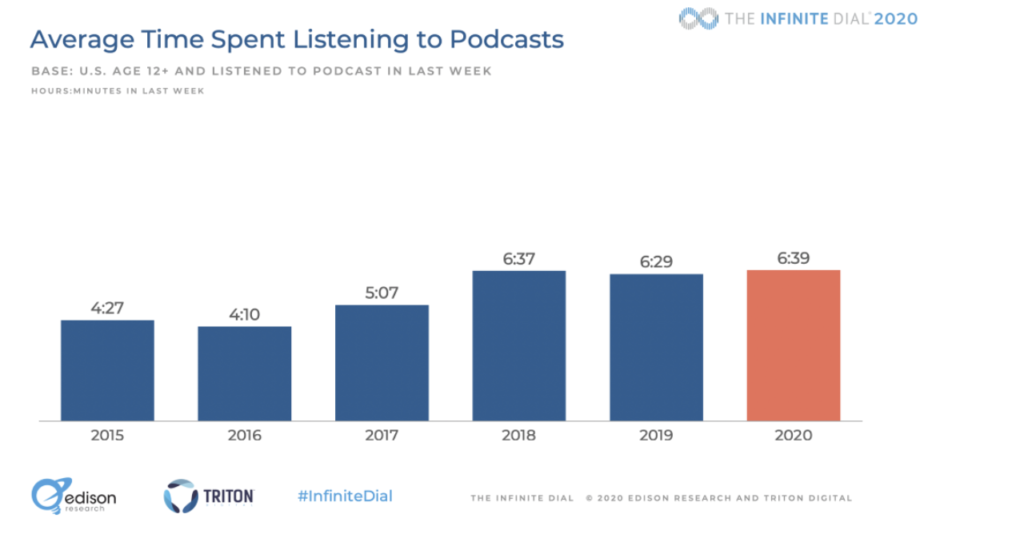Not all audio ads are created equally. Podcasters are increasingly taking advantage of dynamically inserted ads. While this is similar to the dynamically inserted ads used in the online streaming of radio stations, it’s not exactly the same. To help us dig into the nuances and explore some of the issues surrounding this type of advertising, I’ve enlisted the help of Mark Spencer, who is responsible for Customer Success and Support at Omny Studio, and Mitchell Secrett, the Product and APAC Operations Manager at Omny Studio. Omny Studio is an enterprise podcast hosting platform that is part of Triton Digital. –Seth
What is a dynamically inserted podcast ad?

A dynamically inserted ad is a piece of audio (referred to as the ‘creative’ from here) that is recorded and produced separately from a podcast episode. The creative is ‘stitched’ into the podcast episode file at the time of download when the ad targeting conditions are met. This is opposed to a ‘baked-in’ ad which is part of the original audio file and isn’t dynamically replaced.
The advantage of SSAI (server-side ad insertion) over baked-in ads is that you can serve different creative to listeners of the same podcast episode through several parameters including where they are located (geography), device type (Apple or Android) and which app they’re using to listen (Apple Podcasts etc.) among other things. Additionally, the same creative can be served across many different podcasts. Or, SSAI can be used to replace an older creative with a more recent creative.
If done well, a listener won’t be able to tell the difference between a dynamically inserted host-read ad and a baked-in ad.
What are the metrics used to measure podcast ads?
Impressions, which are downloads of the ad creative within a podcast episode. Here’s the technical definition from the IAB (Interactive Advertising Bureau) v2 guidelines:
“Ad Delivered: an ad that was delivered as determined by server logs that show either all bytes of the ad file were sent or the bytes representing the portion of the podcast file containing the ad file was downloaded.”
For it to meet the official ‘ad delivered’ spec from the IAB, the part of the podcast episode which has an ad in it must be downloaded.
What are the differences between these metrics and traditional U.S. radio metrics?

By following the IAB v2 guidelines, a podcast hosting platform or ad-tech provider can determine how many times a podcast episode was downloaded in a way that is standardized across the industry. Podcast measurement is census-based, meaning every valid download or impression is counted, allowing for detailed reporting by episode, by player/app, and by device.
In contrast, radio ratings use an audience sample size and extrapolate that out to estimate the total listening audience of each station. The benefit is they are able to collect information about the profile of the listener directly from panelists. However, a large sample is required to provide stable results and detailed reporting.
What are the current challenges with podcast metrics?
The main perceived challenge is that you can’t tell definitively if the person who downloaded the episode actually listened to it, unless you control the player or listening endpoint. That’s the reason that both standardized measurement and publication of numbers in the form of industry rankers are needed.
That said, survey data such as Edison Research and Triton Digital’s 2020 Infinite Dial Study shows that podcast listeners are highly engaged, spending an average of 6 hours and 39 minutes listening to podcasts per week.

How do dynamic podcast ads differ from ads that radio stations insert into their livestream?
Same principal, different medium. Dynamic ad insertion in podcasts happens at the time of the download, not necessarily at the time of consumption (listening) – though current listener experiences indicate that most people click to play (or “stream”, as it’s perceived) despite the technical delivery method. Live stream ad replacement happens when the person is listening, so time-based targeting can be more readily employed.
How are you seeing radio stations in the U.S. sell dynamically inserted podcast ads?
This depends on the network and the style of podcast being sold.
Catch-up or ‘time-shifted’ radio podcasts are sometimes bundled as part of an on-air sales package by the existing radio sales team. Whereas original, podcast-first content is usually sold separately and generally, commands a premium price.
There are examples all over the world of radio networks splitting out their original, podcast-first content as a separate division to their radio offering. In the US, Entercom acquired Cadence 13, in Canada, Corus Entertainment has the Curioscast Network, and in Australia, Southern Cross Austereo has Podcast One Australia. This seems to be a global trend in terms of getting the most out of podcasting.
What does the ability to dynamically insert ads mean for programmatic ads in podcasting?
The ability to dynamically insert ads into podcasts provides buyers with more transparency on the campaigns. Buyers can control Key Performance Indicators in real-time and change strategies as needed. Publishers, on the other hand, can use programmatic marketplaces to optimize the yield from their inventory.
We currently see both sides aiming to learn best practices in selling and buying podcasts. As mentioned earlier, an industry wide standard for podcast measurement will shorten the learning curve, helping both sides to understand and recognize the value of podcast audiences and programmatic podcast ads.
In addition to measurement, another challenge for the industry is listener ID information. A distinguishing characteristic of programmatic is data-driven campaigns and today, due the lack of listener ID information being provided to the ecosystem, buyers need to use probabilistic models and rely on household level targeting to include podcasts in large, non-podcast specific campaigns.
What effect do you think increased programmatic advertising will have on the podcasting space?
As programmatic advertising increases in adoption, we’ll see average CPMs increase. Fueled by competition in programmatic growth, where more bids on a unique opportunity result in a higher price for that opportunity.
With this growth, we’ll also see more variety in the advertisers and brands reaching listeners. We should expect to see personalized ads that are strategically placed to match the listener profile, beyond simply geographic targeting.
For large shows and commercial networks, it’s highly likely that programmatic ads will become a significant part of the revenue source – with those shows working on a mix of host read, direct sales and programmatic ad insertion (especially for back catalogue and unsold inventory).
For shows with smaller download numbers, programmatic ads are a way to start monetizing earlier than ever before. With programmatic advertising they become part of a larger pool of options – if alone they are small, together at scale they become a very interesting audience to be reached.
What effect will programmatic ads have on direct response ads?
Direct response ads are how podcast advertising started – a host read ad, baked into the audio file – directing listeners to the advertiser’s website with a coupon code was the best way to prove results. It’s largely a reflection of the advertising industry verifying the effectiveness of podcast advertising. Data thus far shows that podcast advertising is effective, which is opening the door to more brand awareness advertising, which we expect programmatic advertising to follow.
In the IAB advertising report for 2019, direct response advertising is number 1, but brand awareness advertising is on the rise.

Attribution will play a key role in programmatic advertising, as buyers are used to measuring the effectiveness of ad spend. Buyers are aware that just because an impression occurred, it doesn’t necessarily mean that the exposure was effective. Many buyers are having to rethink podcast attribution, as key digital signals may not exist.
Currently, a large percentage of podcast ads consist of copy read by hosts. Will this change with an increase in programmatic advertising?
Possibly, but programmatic still only accounts for a small percentage of podcast advertising revenue in total (approximately 1%, according to the 2019 IAB podcast revenue study), so we don’t expect to see any seismic shift happening soon. That said, host read ads can be particularly effective and will continue to be used in podcasts with large audiences. However, if a brand wants their campaign to run ads across many podcasts to deliver scale, standard audio ads can be placed more efficiently via programmatic.
Let’s talk about brand safety: How do programmatic advertisers ensure that they are not advertising in podcasts with objectionable content?
The safest way for brands to utilize podcasting is to leverage host-reads on vetted shows, but there is also targeting capabilities that vary between ad exchanges that afford advertisers some measure of control, and subsequently power over brand safety.
Programmatic buyers are advised to create safe lists of shows that are compatible with their brands. They can start refining the list using the IAB taxonomy for formats and genre, but it is inevitable that some time-consuming listening research is needed. Once this task is done, targeting only the shows on the list will allow buyers to enjoy all the advantages of programmatic buying.

Let’s look at it from the podcasters’ point of view: How do they ensure that there are no programmatic ads that they object to include in their podcast?
Some ad exchanges allow for the exclusion of ads by IAB category and sub-category, brand, URL, language, ad duration, and more. Podcasters can take advantage of these filters to ensure the ads on their shows match what they expect and are comfortable with. From what we see and hear, both sides are equally concerned about ad mismatches.
Anything else radio stations should know about dynamically inserted ads or programmatic advertising in podcasting?
Although its still early, podcast advertising has more fundamental configurability, flexibility, reporting, and targeting capabilities than over-the-air radio. Dynamic ad insertion enables publishers to deliver host read ads for as many markets, segments, and varieties of your content as you’d like – while your content remains evergreen, accessible, and more valuable than ever.
Additionally, programmatic ads place a high value on your listeners, which hyper-local advertisers are often willing to pay a premium for. Over the air broadcasts are designed to appeal to a much wider home/primary market, whereas programmatic can be utilized to reach highly valued secondary markets.
- A Simple Digital Treat to Thank Your Radio Listeners This Thanksgiving - November 13, 2023
- Interview Questions When Hiring Your Radio Station’s Next Digital Marketing Manager - November 6, 2023
- A Radio Conversation with ChatGPT: Part 2 – Promotions - October 30, 2023





Leave a Reply